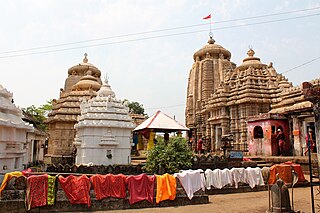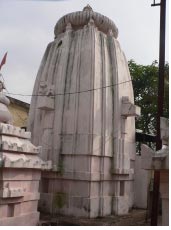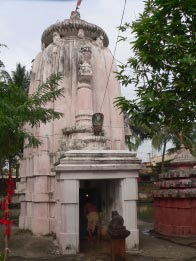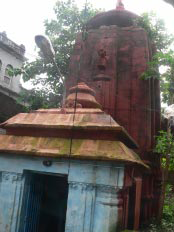Jalesvara Siva Temple Precinct is a Hindu Temple dedicated to Shiva situated on the southern outskirt of the village Kalarahanga at a distance of 2.00 km from Patia and 6.00 km south of Chudangagada in the northern outskirt of Bhubaneswar, Odisha, India. The presiding deity is a Siva-lingam within a circular yonipitha inside the sanctum, which is 1.15 meters below the chandrasila. The sanctum measures 2.00 square meters.
Kalabhairavi Temple is located at Bhubaneswar of Odisha, India within the Jaleswar Siva Temple Precinct, Kalarahanga. The enshrined deity is a four armed Chamunda sitting over a dead body. The deity holds a khatuanga in her upper right hand, a snake in upper left hand, a severed head in lower left hand and the lower right hand is broken. The deity is crowned with jatamukuta and wearing a garland of skull. The whole image rests over a pedestal measuring 0.50 metres in height.

The Kapilesvara temple is a Hindu temple dedicated to Shiva located in the south western outskirt of the village Kapilesvara, Old Town, Bhubaneswar, Odisha, India. It is located at the end of Kapilesvara road leading from Lingaraj temple to Kapilesvara Village. The presiding deity is a Siva-lingam at the center of a circular yonipitha inside the sanctum. It is a living temple, facing towards east and maintained by Kapilesvara Temple Trust Board. The temple is situated within the precinct along with 33 other monuments. The precinct is located on the northern embankment of Manikarnika tank over an area of 44.00 square metres.

Lokanatha Siva Temple also Amunha Deula is an 11th-century AD temple in Bhubaneswar in the state of Odisha, India. It represents a proto type of Lingaraja in a miniature form. Lokanatha Siva temple is located in front of the Lingaraja temple in the south eastern corner across the road and adjacent to Lingaraja Temple Police Station in Old Town, Bhubaneswar. Until 1972 the temple was buried from all sides up to the bandhana portion, giving an impression as if the temple had no entrance. Hence people called it Amuha deula. In 1972 Debala Mitra conducted an excavation in front of the northern wall and exposed the entrance. The sanctum was empty. However, on the basis of the local traditions and the sculptural embellishment on the outer wall it was ascribed to Lord Siva. It is now known both as Lokanatha Siva and Amuha deula. People ascribe the temple to the Kesharis (Somavamsis). Except the entrance all other sides it is buried up to the bandhana.

Arjunesvara Siva Temple is an abandoned 12th century temple in Bhubaneswar, in the Indian state of Orissa. The temple is situated on the southern embankment of the Bindusagar tank on the right side of the ratha road branching from the road connecting Lingaraja temple to Ramesvara temple.

Purvesvara Siva Temple is located in Kancha Sahi, in the Old Town of Bhubaneswar, Orissa, India. It was built in 13th century AD. It is a living temple and now under the care of Purvesvara Temple Development Association.
Bhrukuteswar Shiva Temple is situated in Yamesvara Patna, Old Town, Bhubaneswar in Odisha, India. It is a single structure pidha deul without any frontal porch. According to the local people this temple was built by the Kesaris (Somavamsis).
Markandesvara Siva Temple was constructed by Kesaris to commemorate the visit of sage Markandeya, same as the Samesvara Siva temple. It is an abandoned temple and is facing towards the east. However at the center of the sanctum there is a Siva-lingam with the circular Yoni pitha. The temple is totally covered with wild vegetations.
Nilakantha Siva temple is located in the Kharakhia Baidyanatha temple precinct, Kharakhia Vaidyanath Sahi, Old Town, Bhubaneswar. One can approach to this site on the left side of the Vaidyanath road leading from Lingaraja temple to Kapilesvara. This is a living temple and is facing towards the west. The enshrining deity of this temple is a Siva lingam within a circular yoni pitha at the centre of the sanctum sanatorium. The sanctum is 0.77 metres below the chandrasila.
The Somesvara Siva temple is located in the Kharakhia Baidyanath temple precinct in Kharakhia Vaidyanath Sahi, Old Town, of Bhubaneswar. It is located approximately 300 metres south of Lingaraja temple. Visitors may approach the site on the left side of Baidyanath Road leading from Lingaraja temple to Kapilesvar. It is a living temple and faces towards the west. The enshrined deity of this temple is a Siva lingam within a circular yonipitha at the center of the sanctuary located 0.93 metres below the chandrasila. The temple is under the care and maintenance of Babulal Makaddam Badu Mohapatra, the chief priest of the temple, on whose private land the temple stands.
Patalesvara Siva Temple – III is a Siva temple located on the Mandir Chowk of Old Town, Bhubaneswar, Orissa, India. The temple dates to the 13th century AD.

Isanesvara Siva Temple is a 13th-century ad temple in Bhubaneswar in the state of Orissa, India. The date of its construction is estimated from its architectural features and it is suggests the temple to ganga period. Isanesvara Siva temple is in the Goasagaresvartemple precinct, on the left side of Ratha road old Town, Bhubaneswar. It is one kilometre (0.62 mi) west of Lingaraja Temple and one km south of Ananta Vasudev, 300 m (980 ft) southwest of Ramesvara temple and 200 m (660 ft) northwest of Baitala Deula. The temple is facing towards east. The presiding deity is only a circular yon pitha. The lingam is missing.

Paradaresvara Siva Temple is a 13th-century AD temple in Bhubaneswar, Odisha. The time period of its construction is estimated from its architectural features and it suggests that the temple must belong to the ganga period. Paradaresvra Siva temple is situated in the Gosagaresvar temple precinct. It is located on the left side of Ratha road old town, Bhubaneswar. It is located at a distance of 1 km west of Lingaraja Temple and 1 km south of Ananta Vasudev, 300 metres southwest of Ramesvara Temple and 200 metres northwest of Vaital Temple. The temple is facing towards east. The presiding deity is only a circular yonipitha in the cella that measures 3 square metres. The lingam is missing.
Kartikesvara Siva Temple is situated at a distance of about 100 m from eastern gateway of Lingaraj temple. It is on the left side of the temple road leading from Lingaraja to Garej Chowk, Bhubaneswar, within the precinct of Gandhi Garabadu which is now under the Lingaraja Temple Administration.

The Tirthesvara Siva temple is a Hindu template located in Bhubaneswar, the capital of Odisha, India.
Lakhesvara Siva temple Location: Lat 20° 14’ 33"N, Long 85° 50’ 17" E, Elev 60 ft. Approach- Lakhesvara Siva temple is located in the right side of the Ganges–Yamuna road, behind the Lingaraja market complex, Old town, Bhubaneswar, Orissa, India. It is situated at a distance of 70 metres north east of Lingaraj temple and at a distance of 10 metres south of Gangesvara and Yamunesvara Siva temple across the road. The temple is facing towards the east. The enshrining deity is a Siva lingam within a circular yoni-pitha, which is 0.77 metres below the chandrasila.

Mangalesvara Siva Temple is a Hindu temple located in Bhubaneswar, Orissa, India. It is located at Lat- 20◦ 14’ 38" N., Long- 85◦ 50’ 38" E., and at an elevation of 45 ft.
Papanasini Siva Temple is an abandoned Hindu temple located in Bhubaneswar, Orissa, India.
Sukutesvara Temple located in the old town of bhubaneswar, Odisha,India,serves as purpose for community gathering. The preceding deity in this temple is a Siva- lingam situated at the centre. The temple observes various religious sacraments like Mahasivaratri, Chandipatha and Rudrabhisekha.
Sinduresvara Siva temple is located in village Sundarpada, Old Town, Bhubaneswar, Odisha, India. It is on the right side of the road leading from Lingaraj temple to Sundarpada. The enshrined deity is a circular yonipitha facing towards the north. The Siva lingam decayed in course of time. In April 2013 the villagers raised funds and reestablished new Shiv Linga. There are two entrances on the south-west and northwest corners provided with seven flights of steps leading down to the temple.






